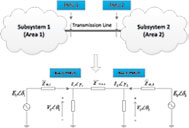Power Grid Stability Analysis based on Synchronized Phasor Measurements
Jiangmeng Zhang with adviser A. Domínguez-García
This research focuses on the acquisition and utilization of phasor measurement unit (PMU) phasors in stability analysis of the power grid. First, a method to monitor system stability by processing the PMU data in the frequency domain is proposed. Next, a modified Thevenin equivalent model is presented. From this, a power system can be modeled as an equivalent circuit, as shown in Figure 26, without knowing the system network topology information. The equivalent parameters are estimated based on phasor measurements by applying Kirchoff’s voltage law and the least square estimation method. System equivalent inertia, as a critical parameter for transient stability analysis, is also estimated by taking advantage of the frequency domain analysis.
Based on this equivalent model, the system stability margin (SM) can be quantified as a function of the phase difference across the system. The system transient performance for fault analysis can also be evaluated with the equivalent circuit and parameters. This whole stability analysis method is verified in a test bed as shown in Figure 27. The frequency domain value of one example set of phasor measurements is presented. Results show that when the system goes to blackout, the calculated SM is 0, which validates our method. Further transient analysis will be performed in the test bed. This research is supported by the Trustworthy Cyber Infrastructure for the Power Grid.
This research is funded by the Grainger Center for Electric Machinery and Electromechanics.

